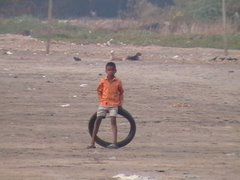Bloody Truth
Meena discovered she had been sold by her boss while riding in an auto-rickshaw headed to New Delhi’s red-light district.
The 12-year-old was working as a domestic servant in Calcutta when the homeowner told her about a good-paying job at his sister’s house in India’s capital. But instead, she was sold to a brothel owner and forced into prostitution for little more than a place to sleep and the occasional meal.
Her ordeal lasted four years and Meena, now 21, says it left her “a very angry person.”
“The anger comes suddenly,” says Meena, who asked that her full name not be used because of the stigma associated with her past.
Beneath the surface of India’s rapid economic development lies a problem rooted in the persistent poverty of hundreds of millions of Indians. Rights activists say thousands of poor women and girls are forced into prostitution every year after being lured from villages to cities on false promises of jobs or marriages.
Much of the attention on human trafficking focuses on the estimated 600,000 to 800,000 people – about 80 percent of them women or girls – who are trafficked across international borders every year, and, in many cases, forced to work as prostitutes or virtual slaves who perform menial tasks.
But those numbers don’t include victims trafficked within their own countries – a problem that has long plagued India, a country large and diverse enough that traffickers can take victims from one place to another hundreds of miles away where a different language is spoken and there’s little chance of the women finding their way back home.
“This is a challenge to India’s contention that it is both democratic and modern,” said Ruchira Gupta, founder of the anti-trafficking group Apne Aap. “In this day and age, when democracy is supposed to exist in India . . . we have so many slaves.”
The secrecy of the underground business makes it difficult to track, and the estimates for the numbers of India’s victims each year vary widely.
But this much is known: the government estimates there are 3 million sex workers in India, at least 40 percent of them children. And thousands of them are believed to have been unwittingly lured into the work by traffickers, rights activists say.
Most of the girls come from India’s poorer states. A family member or friend approaches the girl’s parents about a well-paying job in the city or the chance for marriage with little or no need to pay a dowry.
In some cases, parents sell the girls directly. Prices range from several hundred to several thousand dollars.
Traffickers are rarely caught. The U.S. State Department said in an annual report on human trafficking last year that India’s law enforcement response to the problem was weak and prosecutions rare.
In Mumbai, which has the highest concentration of sex workers, only 13 traffickers were arrested in 2005, and none were convicted, according to the State Department. The situation was similar in other cities.
“One of the best ways to prevent trafficking is to increase convictions of trafficking – and this is not happening,” said Gupta. “Women are being rounded up for soliciting in a public place, but there are very few arrests of men who are running the whole trade – the buyers, the pimps, transporters.”
Deepa Jain Singh, secretary for India’s Ministry of Women and Child Development, said the government is “trying to do more” about the problem of sex trafficking, but he declined to specify what steps were being taken.
What becomes of the girls? There are many pitfalls. HIV infections among sex workers are widespread in a country with an estimated 5.7 million people infected with the disease.
And women who manage to escape are often rejected by their families, leaving them poor and alone in a society where family means almost everything.
Meena’s childhood before being sold into prostitution was filled with long days of domestic work in the rural eastern state of Jharkhand. She received little or no pay, she said, but “I was so poor, I could not leave.”
At the urging of her mother, she moved to Calcutta for what she was told would be a paid maid’s position. When her boss then sent her to New Delhi, Meena never found out the price she brought on the human trafficking market.
She was rescued from the brothel by STOP, an anti-trafficking group founded in 1998. She lives in the group’s shelter on the western edge of New Delhi, a large two-story white house with long hallways situated amid the farm fields that spread out from the city’s edge. There are vegetable gardens, and the women who live there embroider and cook for each other.
It’s run by Roma Debabrata, a 59-year-old academic who founded STOP. Two years ago, the group built the 22-room shelter where more than 40 women attempt to rebuild their lives.
Debabrata’s goal is to make the girls and women in the house function “like a normal family.”
“I don’t expect miracles from them. They’re very normal people and they’re being nurtured here in very natural surroundings,” she said. “We want them to go from victim to survivor to activist. It’s a long journey.”
The organization has built an information network, with tips called in to a hot line operated out of an unmarked office. The staffers work with local police to raid brothels and rescue endangered girls.
Some are resettled with their families or married, aided by STOP’s counseling services.
But for many, moving back to their villages is not an option.
“I love to be here because I’ve got my mother, my father, my siblings,” said Meena, referring to her house mates. “I never feel this is someone else’s home. It is my own.”






No comments:
Post a Comment